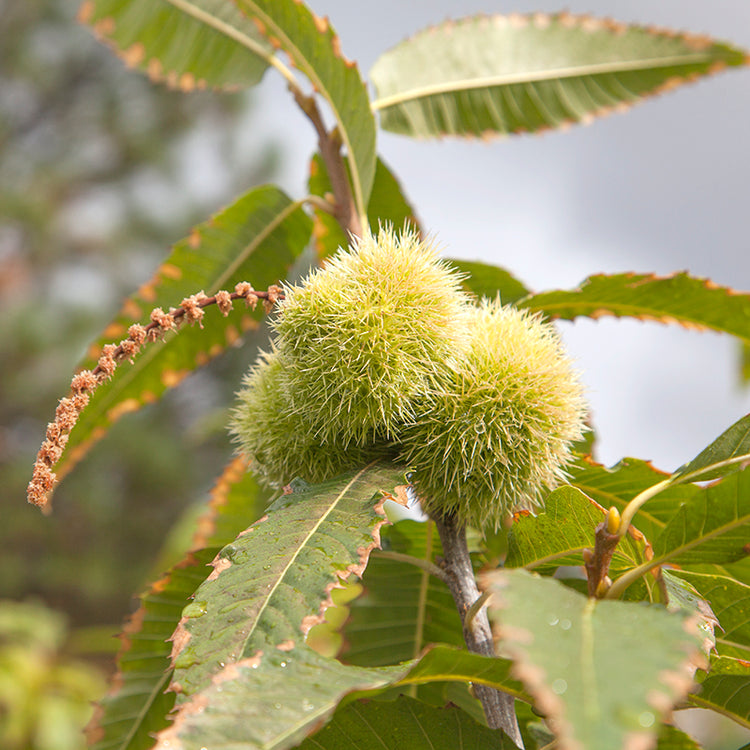Collection: Chestnut Trees
Plant a bare root chestnut tree for roasted nuts in the winter

No products found
Use fewer filters or remove all

Bare root chestnut trees (Castanea spp.) are a valuable addition to any landscape, offering delicious nuts, ornamental beauty, and shade. While growing these trees from bare root stock may seem daunting, with the right knowledge and care, you can enjoy a bountiful harvest of chestnuts and the many benefits they bring to your garden. In this guide, we will walk you through the process of growing bare root chestnut trees, from selecting the right variety to planting and care.
Selecting the Right Variety: Before embarking on your chestnut tree journey, it's essential to choose the right variety that suits your climate and needs. Some common chestnut tree varieties include:
-
American Chestnut (Castanea dentata): Once abundant in North America, American chestnut trees are highly resilient and well-suited to temperate regions. However, they are susceptible to chestnut blight, so selecting blight-resistant varieties is crucial.
-
Chinese Chestnut (Castanea mollissima): Chinese chestnut trees are known for their resistance to chestnut blight. They produce sweet and flavorful nuts, making them popular for orchards and home gardens.
-
European Chestnut (Castanea sativa): European chestnuts are grown for their large, sweet nuts. They are well-suited to regions with mild, Mediterranean climates.
-
Japanese Chestnut (Castanea crenata): Japanese chestnut trees are appreciated for their resistance to chestnut blight and the sweet nuts they yield.
Planting Bare Root Chestnut Trees:
-
Site Selection: Chestnut trees thrive in well-drained, loamy soil with a slightly acidic to neutral pH (pH 5.5 to 7.0). Choose a sunny location that receives at least 6 to 8 hours of sunlight daily.
-
Soil Preparation: Prepare the planting hole by digging a wide and deep pit, approximately two to three times the size of the root system. Incorporate organic matter like compost or well-rotted manure into the soil to enhance fertility and drainage.
-
Planting Depth: When planting a bare root chestnut tree, ensure that the graft union (if present) is above the soil line. Gently spread the roots in the planting hole, ensuring they are not crowded or twisted.
-
Backfill and Watering: Fill the hole with soil, tamping it down gently as you go to eliminate air pockets. Water the newly planted tree thoroughly to settle the soil around the roots.
-
Mulching: Apply a layer of organic mulch around the base of the tree, leaving a small gap around the trunk to prevent rot. Mulch helps retain soil moisture and suppress weed growth.
Care and Maintenance:
-
Watering: Chestnut trees require regular watering, especially during the first few years of growth. Keep the soil consistently moist but not waterlogged.
-
Fertilization: Apply a balanced, slow-release fertilizer in the spring to provide essential nutrients for tree growth. Follow the recommended dosage on the fertilizer package.
-
Pruning: Prune your chestnut tree to establish a strong scaffold structure and remove any dead or diseased branches. Proper pruning helps improve air circulation and sunlight penetration.
-
Protection: Chestnut trees can be susceptible to pests like chestnut weevils and diseases like chestnut blight. Monitor your trees regularly and take appropriate measures to protect them.
-
Harvesting: Depending on the variety, chestnuts are typically ready for harvest in the late summer to early fall. Wait until the spiky outer husk splits open before collecting the nuts.
Growing bare root chestnut trees can be a rewarding experience, providing you with delicious nuts and the aesthetic appeal of these majestic trees in your garden. By selecting the right variety, planting correctly, and providing adequate care, you can enjoy a bountiful harvest of chestnuts for years to come. Whether you're an experienced gardener or a novice, the journey of cultivating chestnut trees is a worthwhile endeavor that offers both practical and aesthetic benefits to your landscape.
For more information, see our Fruit Tree Central collection of blogs and videos.
